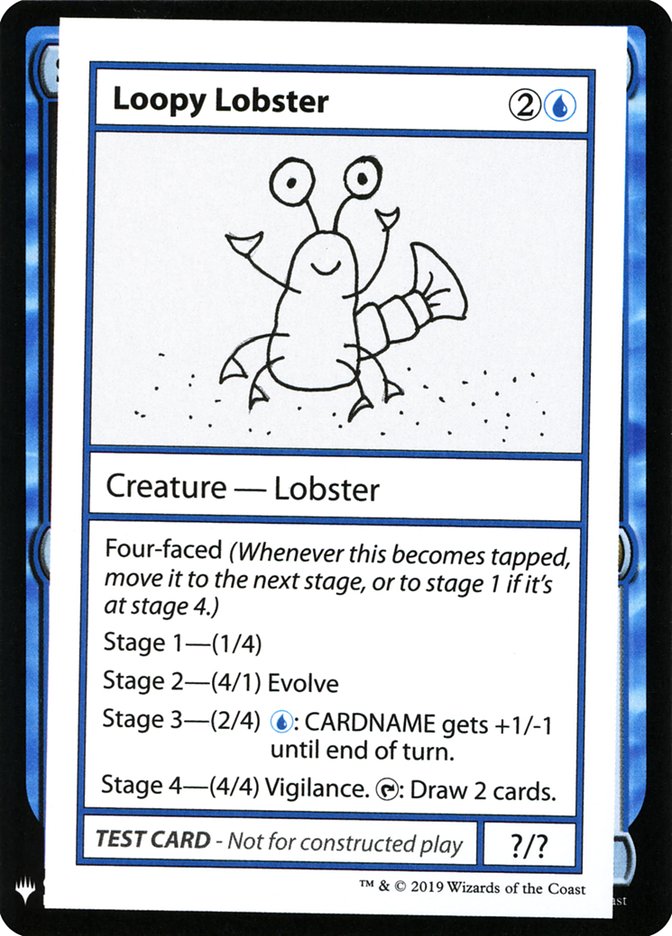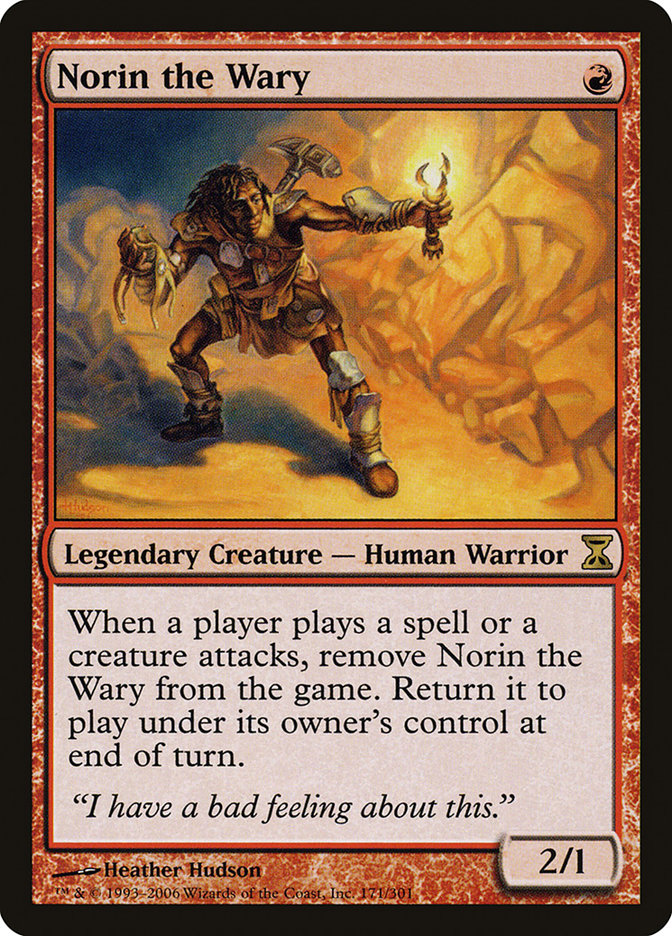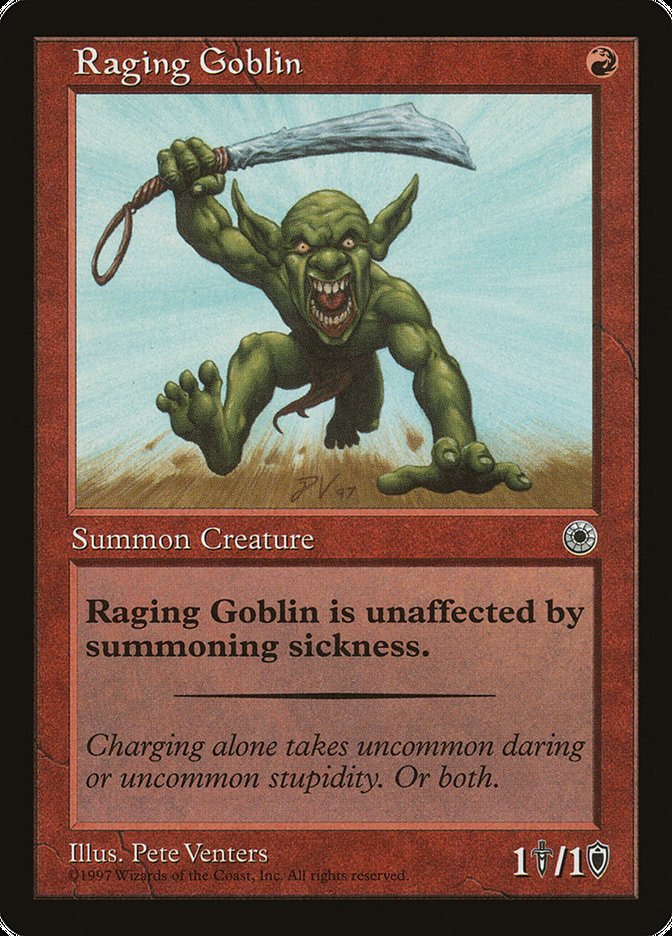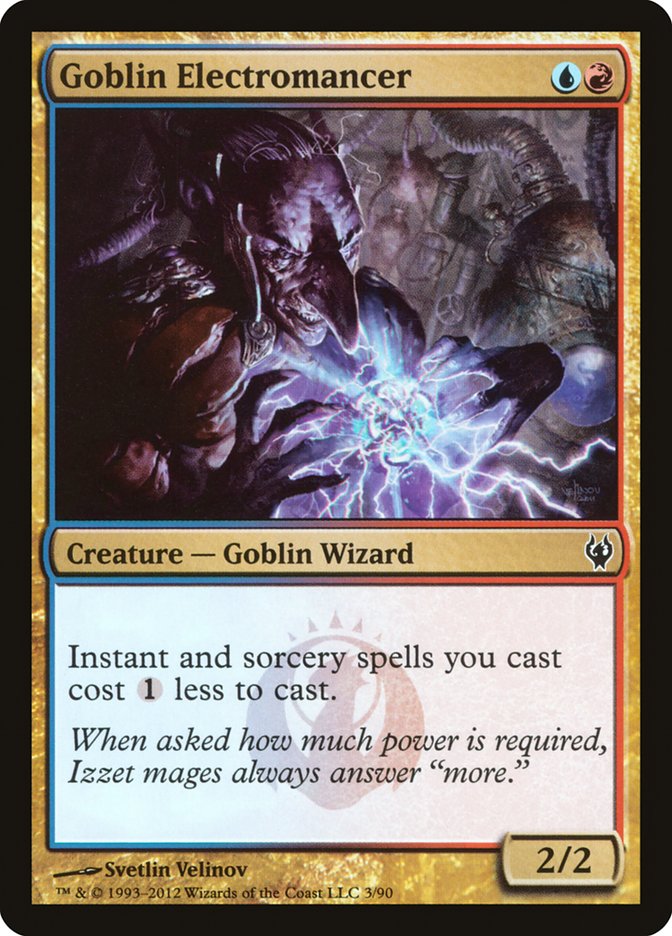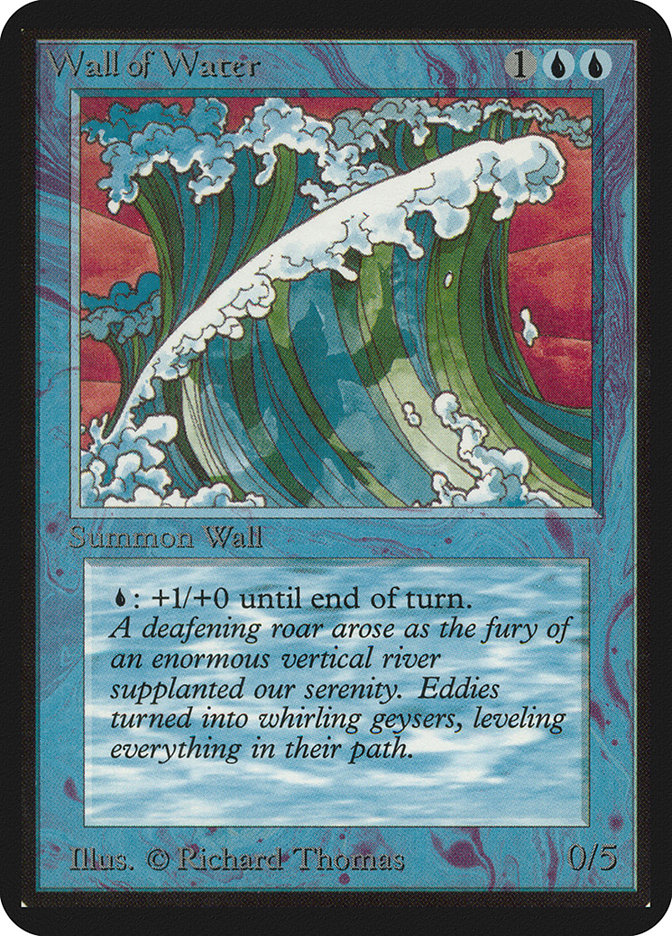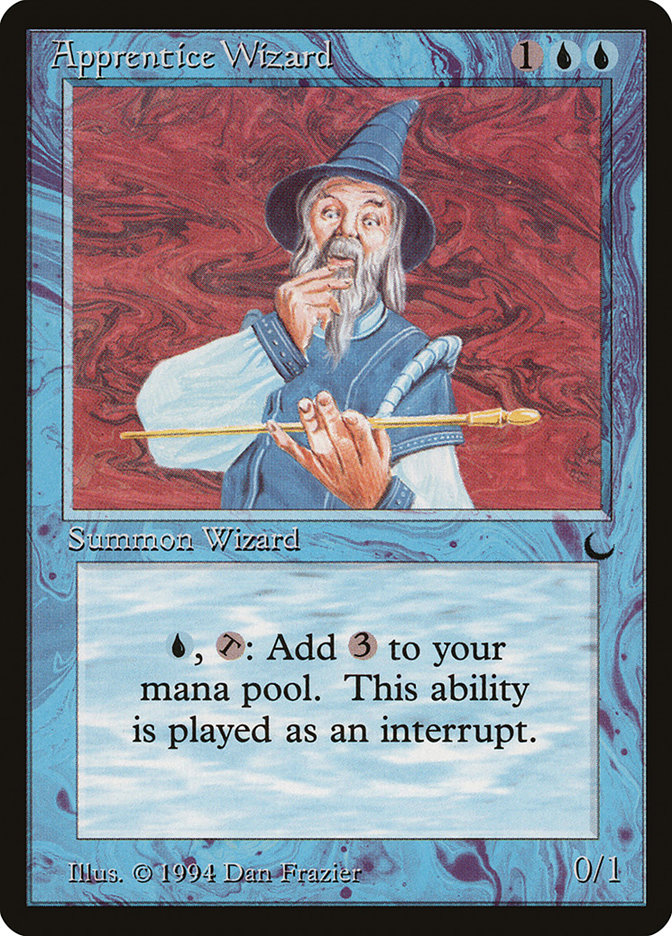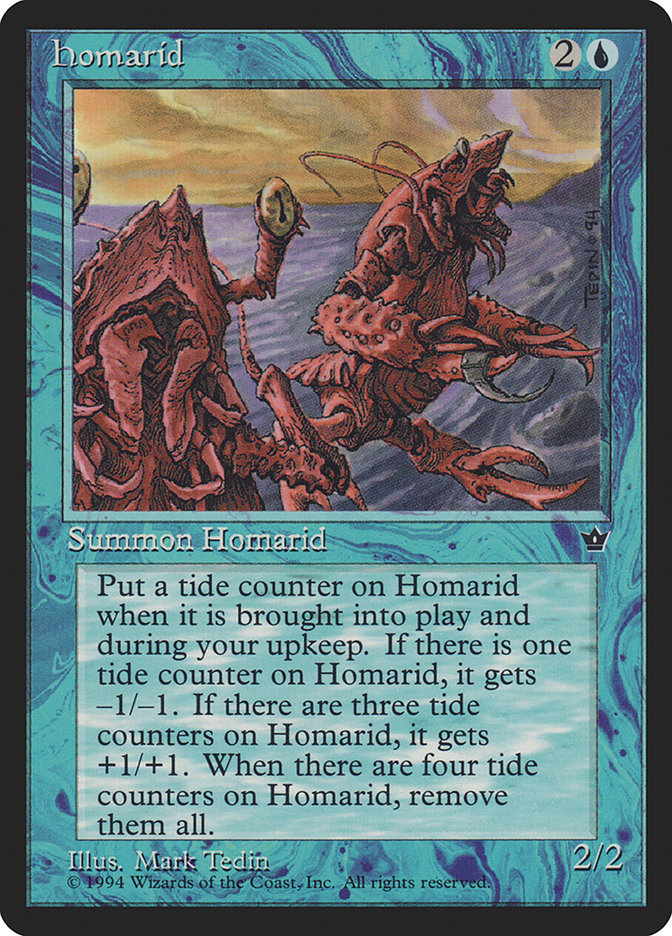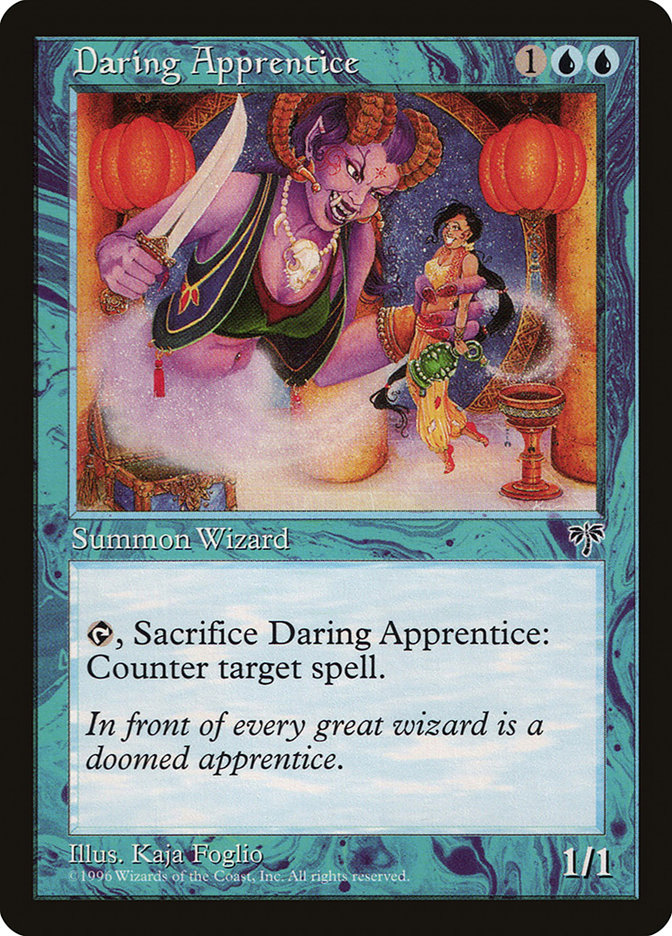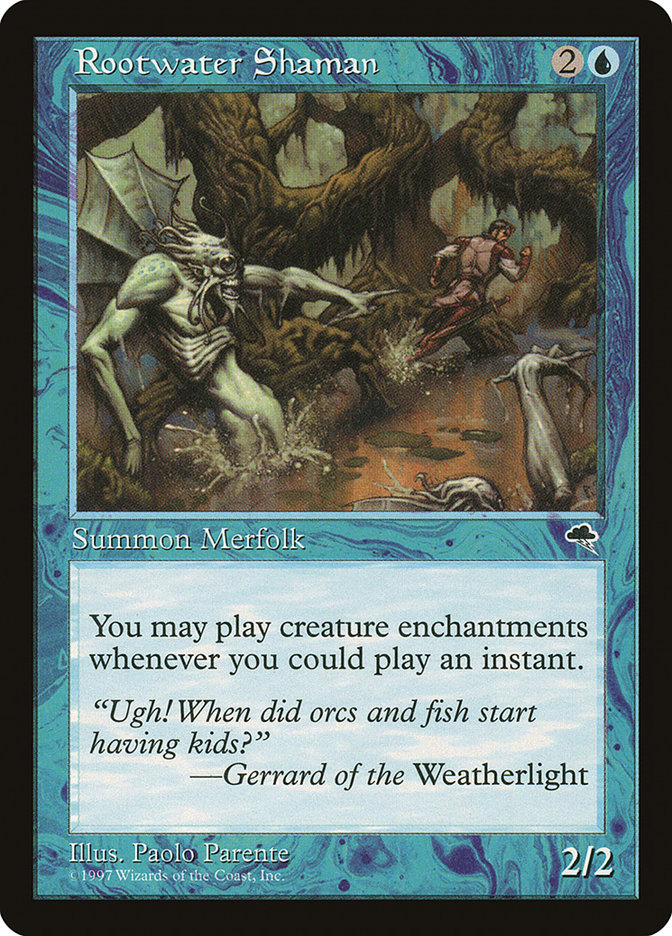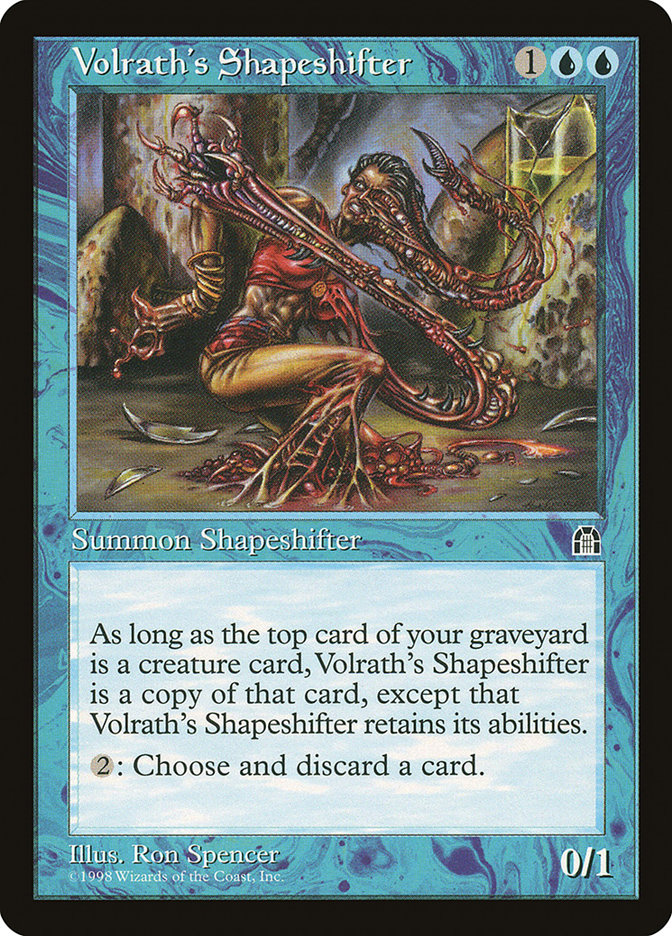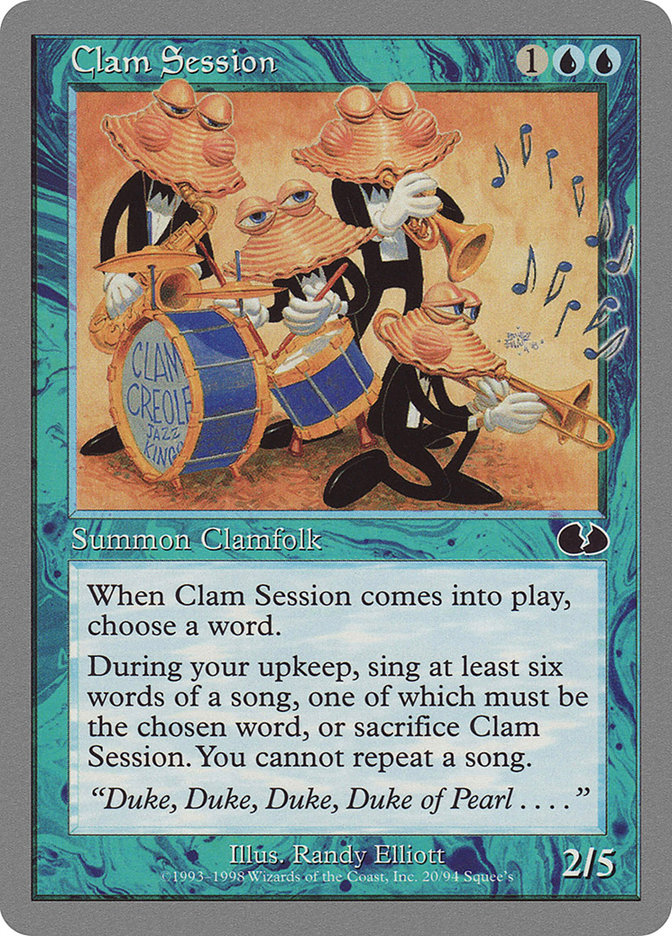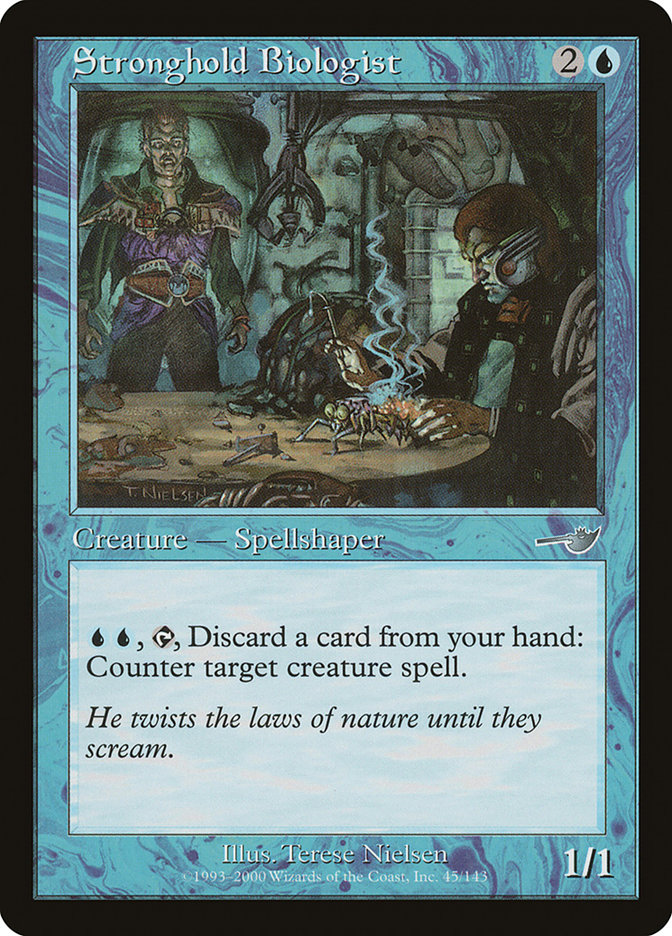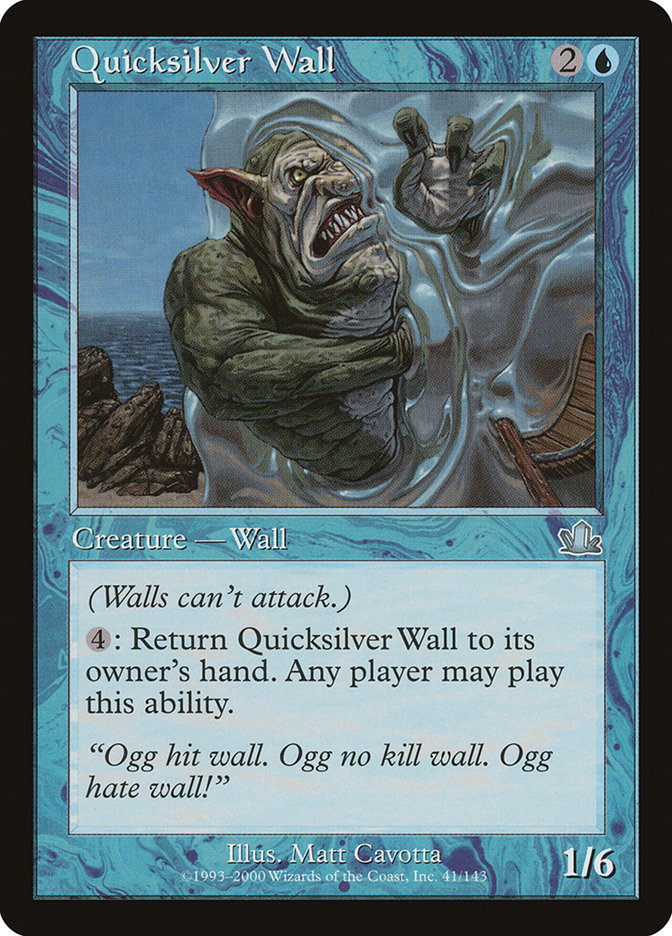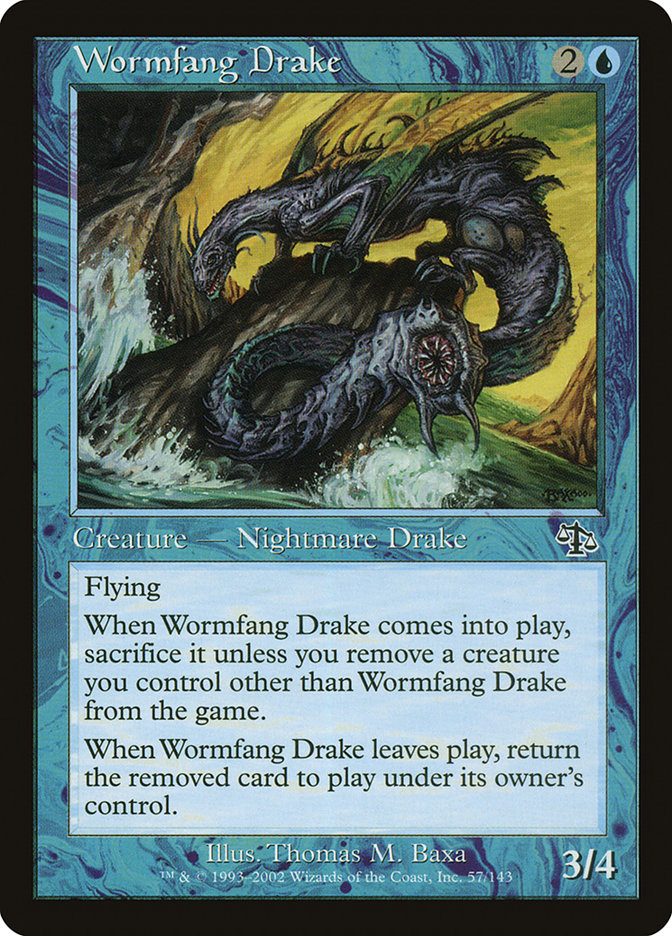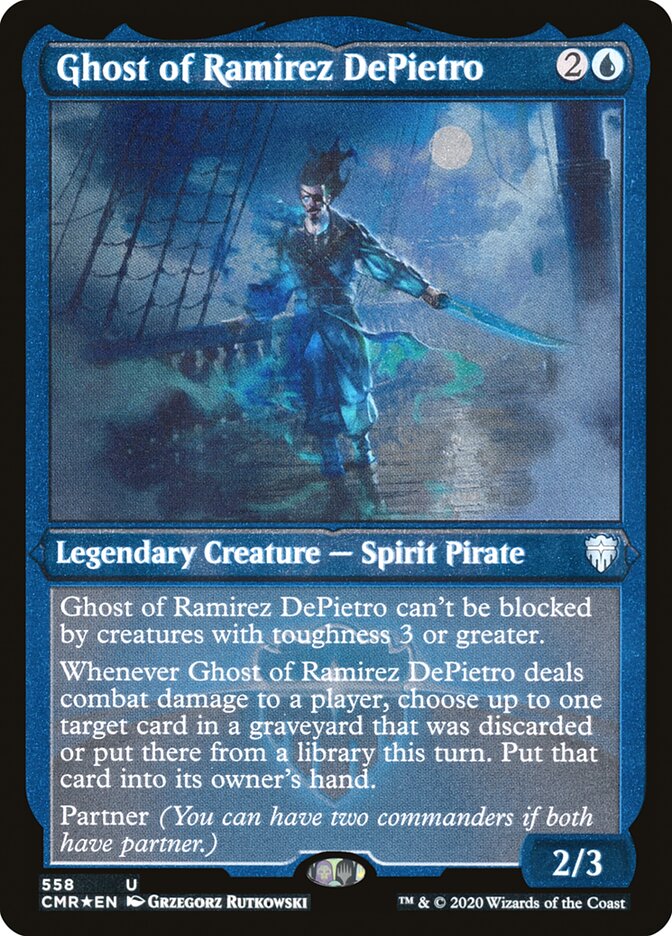Loopy Lobster MTG Card
| Card sets | Released in 2 setsSee all |
| Mana cost | |
| Converted mana cost | 3 |
| Rarity | Rare |
| Type | Creature — Lobster |
| Power | ? |
| Toughness | ? |
Text of card
Four-faced (Whenever this becomes tapped, move it to the next stage, or to stage 1 if it's at stage 4.) Stage 1 — (1/4) Stage 2 — (4/1) Evolve Stage 3 — (2/4) : CARDNAME gets +1/-1 until end of turn. Stage 4 — (4/4) Vigilance. : Draw 2 cards.
Cards like Loopy Lobster
The allure of Loopy Lobster in the realm of Magic: The Gathering lies in its unique quirks among creature cards. It invites comparisons to other quirky creatures with benefits tied to specific conditions or actions. An interesting parallel can be drawn with the card Norin the Wary. Like Loopy Lobster, Norin is known for his ability to evade danger, though Norin does so through bouncing back to hand, while Loopy Lobster’s mechanics might involve something more bemusing or conditional.
Comparatively, the likes of Raging Goblin present a more straightforward approach, offering haste to attack quickly without the elaborate setup that Loopy Lobster might require. Moreover, in terms of battlefield impact, Goblin Electromancer stands out for its ability to reduce the cost of your instants and sorceries, possibly offering a different kind of advantage over Loopy Lobster’s potentially roundabout benefits.
Ultimately, while Loopy Lobster may enchant players with its offbeat charm, evaluating its place beside similar cards is key. Cards like Norin the Wary provide a measure of unpredictability akin to Loopy Lobster, whereas others like Raging Goblin and Goblin Electromancer offer more consistency in their contributions to the game’s dynamics.
Cards similar to Loopy Lobster by color, type and mana cost
Card Pros
Card Advantage: The Loopy Lobster Mtg card includes a mechanism allowing you insight into the next cards of your deck. This sneak peek affords strategic planning, potentially giving you the upper edge in outmaneuvering opponents.
Resource Acceleration: With every successful play or triggered ability, the Loopy Lobster card provides the opportunity to untap lands or artifacts. This subtly boosts your resources, paving the way for deploying more spells or activating abilities sooner than expected.
Instant Speed: The capability to cast Loopy Lobster at instant speed offers a tactical advantage. It lets you react swiftly to the evolving battlefield, disrupt opponents’ strategies, and maximize your turn efficiency by utilizing your mana in the most opportune moments.
Card Cons
Discard Requirement: One downside of the Loopy Lobster card is the requirement to discard another card. This can be particularly challenging when your hand is nearly empty, forcing you to make tough decisions about resource management during play.
Specific Mana Cost: Leveraging Loopy Lobster effectively entails a specific mana cost that includes blue mana. This requirement might restrict the card’s inclusion only to decks that run blue or have a reliable mana base to accommodate blue spells, potentially limiting the card’s versatility across various deck types.
Comparatively High Mana Cost: With a higher mana cost to bring Loopy Lobster into the battlefield, players might find themselves in situations where the card’s benefits are outweighed by other cards with lower cost but similar capabilities. In a fast-paced game where tempo is key, the mana investment in Loopy Lobster might not always align with a strategic advantage.
Reasons to Include in Your Collection
Versatility: Loopy Lobster offers flexibility for decks that thrive on quirky plays and unexpected lines of attack. It’s a unique addition that can adapt to various situations on the board.
Combo Potential: This card is a catalyst for chain reactions in decks built around synergistic creature abilities. Its entry or triggered effect can be the linchpin for setting off a domino effect that leads to a winning board state.
Meta-Relevance: In a game environment where adaptability is key, Loopy Lobster holds its ground. Its unique abilities can create advantageous scenarios against popular deck types, giving players an edge in the shifting landscape of competitive play.
How to beat Loopy Lobster
Loopy Lobster has swiftly made a splash in the current metagame for its ability to frustrate opponents by returning to the hand when targeted. Navigating around this quirky mechanic requires strategy and patience. Tactics like employing board-wide removal spells or effects, which do not target, can prove efficient in bypassing the Lobster’s elusive nature. A card such as Wrath of God, devoid of targeting restrictions, can clear the board and send the crustacean to the graveyard without providing an opportunity for its ability to trigger.
Alternatively, imposing a tax on spells and abilities your opponent controls through cards like Thalia, Guardian of Thraben, increases the cost of utilizing Loopy Lobster’s return ability. This can limit its effectiveness and the opponent’s capacity to bounce and replay it. A subtle yet effective method involves utilizing spells that change control of the creature, such as Confiscate or Mind Control; if you become the controller of Loopy Lobster, its ability loses its defensive advantage for your opponent.
The key is to evaluate the board and utilize non-targeting spells or strategic control shifts to negate the Loopy Lobster’s defense. Mastery of this approach will ensure that this pesky creature won’t put a dent in your game plan.
Where to buy
If you're looking to purchase Loopy Lobster MTG card by a specific set like Mystery Booster Playtest Cards 2019 and Mystery Booster Playtest Cards 2021, there are several reliable options to consider. One of the primary sources is your local game store, where you can often find booster packs, individual cards, and preconstructed decks from current and some past sets. They often offer the added benefit of a community where you can trade with other players.
For a broader inventory, particularly of older sets, online marketplaces like TCGPlayer, Card Kingdom and Card Market offer extensive selections and allow you to search for cards from specific sets. Larger e-commerce platforms like eBay and Amazon also have listings from various sellers, which can be a good place to look for sealed product and rare finds.
Additionally, Magic’s official site often has a store locator and retailer lists for finding Wizards of the Coast licensed products. Remember to check for authenticity and the condition of the cards when purchasing, especially from individual sellers on larger marketplaces.
Below is a list of some store websites where you can buy the Loopy Lobster and other MTG cards:
 BUY NOW
BUY NOW BurnMana is an official partner of TCGPlayer
- eBay
- Card Kingdom
- Card Market
- Star City Games
- CoolStuffInc
- MTG Mint Card
- Hareruya
- Troll and Toad
- ABU Games
- Card Hoarder Magic Online
- MTGO Traders Magic Online
See MTG Products
Printings
The Loopy Lobster Magic the Gathering card was released in 2 different sets between 2019-11-07 and 2021-08-20. Illustrated by Rachel Turian.
| # | Released | Name | Code | Symbol | Number | Frame | Layout | Border | Artist |
|---|---|---|---|---|---|---|---|---|---|
| 1 | 2019-11-07 | Mystery Booster Playtest Cards 2019 | CMB1 | 26 | 2015 | Normal | Black | Rachel Turian | |
| 2 | 2021-08-20 | Mystery Booster Playtest Cards 2021 | CMB2 | 26 | 2015 | Normal | Black | Rachel Turian |
Rules and information
The reference guide for Magic: The Gathering Loopy Lobster card rulings provides official rulings, any errata issued, as well as a record of all the functional modifications that have occurred.
| Date | Text |
|---|---|
| 2019-11-12 | A creature card with four-faced that isn’t on the battlefield is a 0/0 creature. |
| 2019-11-12 | A permanent with four-faced starts at stage 1. |
| 2019-11-12 | Activating Loopy Lobster’s stage 3 ability creates an effect that lasts even if it moves to stage 4 during that turn. |
| 2019-11-12 | Evolve means “Whenever a creature enters the battlefield under your control, if that creature has greater power or toughness than this creature, put a +1/+1 counter on this creature.” |
| 2019-11-12 | If Loopy Lobster somehow enters the battlefield tapped, it will still be at stage 1. |
| 2019-11-12 | If a creature enters the battlefield with +1/+1 counters on it, consider those counters when determining if evolve will trigger. For example, a 1/1 creature that enters the battlefield with two +1/+1 counters on it will cause the evolve ability of a 2/2 creature to trigger. |
| 2019-11-12 | If an object becomes a copy of a permanent with four-faced, that object remains at the stage it was. If it wasn’t at a stage, it’s at stage 1. |
| 2019-11-12 | If evolve triggers, the stat comparison will happen again when the ability tries to resolve. If neither stat of the new creature is greater, the ability will do nothing. If the creature that entered the battlefield leaves the battlefield before evolve tries to resolve, use its last known power and toughness to compare the stats. |
| 2019-11-12 | If multiple creatures enter the battlefield at the same time, evolve may trigger multiple times, although the stat comparison will take place each time one of those abilities tries to resolve. For example, if you control a 2/2 creature with evolve and two 3/3 creatures enter the battlefield, evolve will trigger twice. The first ability will resolve and put a +1/+1 counter on the creature with evolve. When the second ability tries to resolve, neither the power nor the toughness of the new creature is greater than that of the creature with evolve, so that ability does nothing. |
| 2019-11-12 | When comparing the stats as the evolve ability resolves, it’s possible that the stat that’s greater changes from power to toughness or vice versa. If this happens, the ability will still resolve and you’ll put a +1/+1 counter on the creature with evolve. For example, if you control a 2/2 creature with evolve and a 1/3 creature enters the battlefield under your control, its toughness is greater so evolve will trigger. In response, the 1/3 creature gets +2/-2. When the evolve trigger tries to resolve, its power is greater. You’ll put a +1/+1 counter on the creature with evolve. |
| 2019-11-12 | When comparing the stats of the two creatures for evolve, you always compare power to power and toughness to toughness. |
| 2019-11-12 | Whenever a creature enters the battlefield under your control, check its power and toughness against the power and toughness of the creature with evolve. If neither stat of the new creature is greater, evolve won’t trigger at all. |

Guide to Vigilance card ability
In the strategic universe of Magic: The Gathering (MTG), the vigilance ability stands out as a powerful tool for players. This potent keyword allows creatures to attack without tapping, keeping them ready and alert to defend against incoming threats. It represents a perfect balance between aggression and defense, offering a dynamic approach to gameplay. Lets dive deeper into how vigilance shapes the battlefield.
